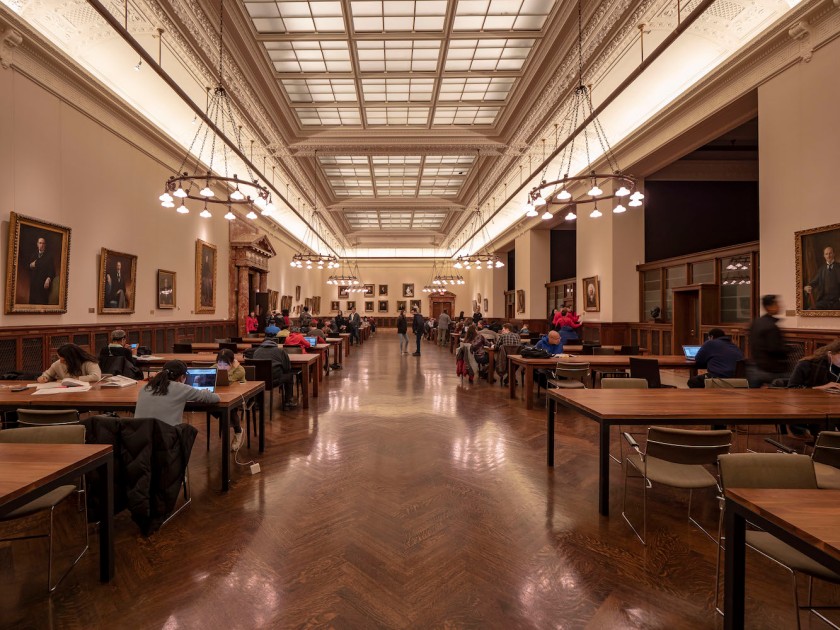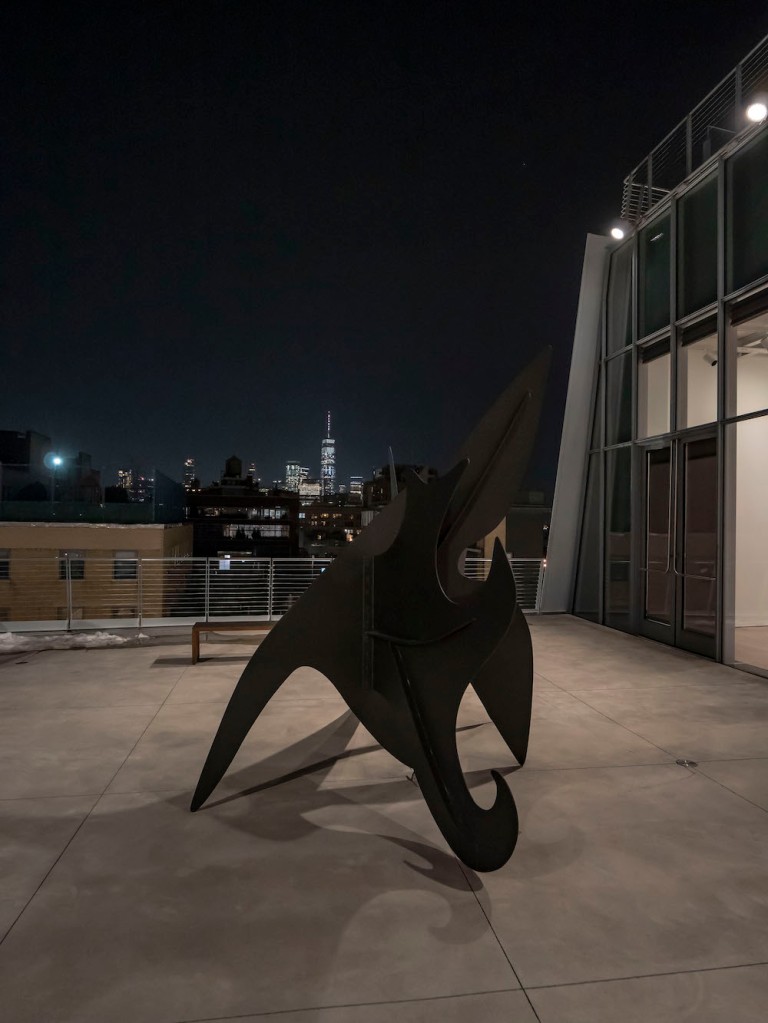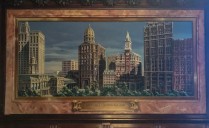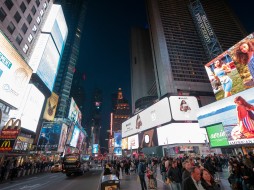President Theodore Roosevelt Birthplace National Historic Site
Victoria McClendon-Leggett
Our first item of business on day two in New York was to visit the birthplace of Theodore “Teddy” Roosevelt. Free tours of the three-story brownstone are led by the National Park Service. We were greeted by Joseph, who would serve as our tour guide, and do so grateful for having an indoor post during the harsh New York winter.

He led us through two stories of Roosevelt’s childhood home (drawing room, sitting room, dining room, master bedroom, and nursery)…

…sharing stories about Roosevelt’s formative years.
The 26th President of the United States was born in 1858 in New York City in what is now the Flatiron district of Manhattan. A sickly child, he spent his earliest years indoors. He suffered frequently from severe asthma attacks, and we learned that during that particular time period asthma was treated with cigar smoke! It was thought that exacerbating an asthma attack would cause it to be over with sooner. The smoggy New York air made it difficult for him to go outside for very long, so he turned to “indoor” activities: he loved to read and also enjoyed taxidermy, even though working with the chemicals sometimes further aggravated his asthma.
When he was around age twelve, Teddy’s father sat him down and told him, “You have the mind, but you haven’t got the body. To do all you can with your mind, you must make your body match it.” His father had an indoor gymnasium built in the house’s courtyard and Teddy would exercise daily. His health improved immensely, and he began to grow into the robust and energetic man that he is more popularly known as.

We thoroughly enjoyed our tour and thanked Joseph on our way out. We posed for a group picture outside the tall brownstone, and then took a short stroll to our lunch destination.

Eisenberg’s Sandwich Shop
Francisco Pena
On NYC’s famous 5th Avenue between 22nd and 23rd Streets is a restaurant that opened its doors in 1929.

Eisenberg’s Sandwich Shop advertises “Raising New York’s cholesterol since 1929” and, without a doubt, it was indeed true for us by the end of our meals. We tried the classic chocolate and vanilla egg cream sodas – a carbonated beverage consisting of milk, carbonated water, and flavoring syrup – but to everyone’s confusion, neither egg nor cream.
We tried a variety of dishes: the Eisenburger (a half-pound of ground sirloin grilled to perfection served with lettuce and tomatoes on a bed of pastrami and sauerkraut);

….a bacon, egg, and cheese burger;

a turkey breast sandwich; Matzo ball soup; and the most succulent Rueben sandwich.

Although some might consider it a true “hole-in-the-wall,” we appreciated the recommendation by a “local,” agreeing that Eisenberg’s was the perfect stop for a delicious meal (thank you Erin Fors!). Running on excess of carbs, we got our bearings and headed out.
New York Public Library Main Branch – Stephen A. Schwarzman Building
Sawyer Massie
From the outside, the Main Branch of the New York Public Library (“NYPL”) retains a commanding presence, although it isn’t a skyscraper like many of its surrounding buildings. Much like other municipal buildings, including City Hall and the Surrogate’s Courthouse, the library contains many Roman architecture motifs and elements such as columns, statues depicting mythological deities, and two marble lions guarding the front entrance (named most recently, Patience and Fortitude).
We started on the third floor and made our way down to the ground floor special exhibit. Each floor had its own special spaces, but we were particularly awed by the grandeur of the building, notably the bronzed ceilings and columns and walls of beautiful marble. That kind of ornamentation or attention to detail is not evident in modern buildings.

From the top, the Rose Main Reading Room captured our attention immediately. Immediately at the top of the stairs is a room about a football field in length covered by a ceiling mural of similar size.

The mural depicts a blue sky with white clouds, a beautiful substitute to a skylight. The floor is lined with rows of tables with vibrant crystal chandeliers hanging above each. This monument to New York is meant for quiet reading and studying and is open to all, which explained the plethora of scholars occupying nearly every seat. We also visited briefly the McGraw Rotunda, an impressive arch with an accompanying mural depicting the history of the written word.
The Edna Barnes Salomon room is most impressive for its art.

They had works by Gilbert Stuart, Charles Peale…

…and Samuel Morse, a fine painter, albeit one better known for his invention (the telegraph).

Down the stairs on the second floor we found in the Jill Kupin Rose Gallery. Named after the wife of former NYPL Chairman Marshall Rose, it holds an ongoing exhibition with large walls of art covering several mediums: photography, paintings, videos, texts, and sculptures. We also found a smaller replica of the Rose Main Reading Room with bronze cherubs on the ceiling and desks filling up the floor space.
On the first floor, the DeWitt Wallace Periodical Room amazed us all. The square room had high ceilings with murals done by a LEAP favorite, muralist Richard Haas (whose connection to Huntsville is in the many external murals he completed there).
Following the theme of periodicals, each mural depicts buildings associated with newspaper publishing in New York. This theme signifies the importance of publishers and newspaper companies at the turn of the century.
Finally, we went to the ground floor of the library to the children’s center in search of the special exhibit. A few of us were delighted to see that the original stuffed animals that inspired the bedtime story of Winnie the Pooh with an accompanying large-scale map drawn by Christopher Robin, the son of A.A. Milne, creator and author of the series.

After many pictures and a brief perusal of the gift shop, we were again off to our next location.
But first, some lagniappe…
Sawyer Massie
On the way to MoMA, we stopped by Grand Central Station. Even though we were there the day before, we were excited to for some lagniappe, “a little something special or extra.” (That’s a word we learned in our Louisiana travels, and we use it when possible.) The Whispering Gallery is located on the Grand Central Terminal dining concourse near the famous Oyster Bar & Restaurant.

There, people can stand on opposite sides of the arched entryways, face the corners, and whisper to one another with the ability to hear the other person perfectly. The design of the rotunda allows for such acoustics to make a whisper seem like a shout but only when facing the corners. Needless to say, it’s no wonder that the Whisper Gallery is a famous spot for marriage proposals.

The Museum of Modern Art (MoMA)
Makayla Mason
Our next stop was the Museum of Modern Art (a.k.a. MoMA). We were excited to see our first art museum of the trip; little did we know it would be the best art museum any of us have been to!
In 2000, The Museum of Modern Art and P.S.1 Contemporary Art Center merged to create the largest platform for contemporary art in the United States, and one of the largest in the world. MoMA boasts a total of six floors with four of them filled with famous artists, many of which were familiar to us. As we had a first-timer with us, we were eager to share what we knew of each artist.
What made the museum magical and exciting was the number of famous original pieces on display: Vincent van Gogh’s The Starry Night…

…Salvador Dali’s The Persistence of Memory….

…and Claude Monet’s Water Lilies….

….Jackson Pollock…

…and Mark Rothko…

Other notable artists included Henri Matisse…

Ellsworth Kelley, Piet Mondrian….

Jasper Johns, and Constantin Brancusi. And of course, an amazing gift shop, we “had” to peruse.
Adventures on the NYC “Trails”
We left MoMA headed for photo ops at Robert Indiana’s LOVE and HOPE sculptures, both only short walks away. We weren’t the only ones; we had to wait in a literal line that had formed to take photos at the LOVE sculpture!

We quickly posed for our photos….

…and then kept moving onward, also stopping at other historical and noteworthy landmarks such as Radio City Music Hall…

….Rockefeller Plaza…

and an “unscheduled” stop at Times Square.
Gansevoort Market
Francisco Pena
Near the Hudson River is Gansevoort Market, named after Peter Gansevoort, an American Revolutionary War colonel. Reminiscent of a market for regional produce, today it offers a food court-style assortment of restaurants of varying cultures. The market has transformed since its first opening day with a crowd that has evolved into a mix of locals of all ages and walks of life. With its history and architecture converted into a modern food court, we were pleased to enjoy dinner there.
We had a variety of warm elections to counterbalance the cold weather, choosing ramen (spicy beef, udon beef, and pork), and spicy salmon poke bowls and salads.

We also couldn’t resist the warm, melted cookies displayed at the front of the Market – and the pink cheesecake cookie covered in glitter was hands-down favorite.

The Whitney Museum of American Art
Sawyer Massie
The Whitney Museum of American Art, named after American socialite and art patron Gertrude Vanderbilt Whitney, is an art museum that solely focuses on 20th and 21st Century American art. Though the art museum owns a total of 17,000 works of art, only about 200 are on display at any given time.
We stepped outside the elevator, greeted by a curated collection of paintings by Jacob Lawrence, revered as one of America’s most renowned African-American painters. Entitled War, the exhibit depicted soldiers in times of grief and celebration in relation to wars throughout the centuries ranging from the Civil War to World War I.
In an adjacent gallery, we saw works of minimalism and modernism, including pieces by Georgia O’Keeffe…

Charles Sheeler, Barnett Newman, Mark Rothko, and Sol LeWitt.

The next room over featured a variety of Regionalists such as John Steuart Curry (with one of his most famous paintings, Baptism in Kansas) and Thomas Hart Benton. (Benton, a LEAP favorite, includes American history and industrial themes in his pieces.)
We also saw an intriguing piece on the Brooklyn Bridge, one done by Joseph Stella.

We snaked through the galleries and were led to an outside balcony area. Just inside was an Alexander Calder mobile; just outside was an even larger Alexander stabile.

The stabile overlooks the New York City skyline and directly faces Freedom Tower from the rooftop–a beautiful display of respect to the artist and a perfect complement to the art itself.
We next found the exhibit entitled Programmed: Rules, Codes, and Choreographies in Art, 1965-2018. This display consisted of art of various mediums centering on the theme of technology, including sound sculptures, light sculptures, videos, short films, and interactive video games, including an intriguing interactive piece by Jim Campbell.

The remaining floors (three in total) were reserved for the main event: Andy Warhol: From A to B and Back Again. The exhibit began by showing his most famous works such as Marilyn Diptych, Cow Wallpaper, and Campbell’s Soup Cans.

This floor showed off Warhol’s works and provided a wonderful introduction into his style of Pop art. We specifically enjoyed Golden Rorschach, a variation of the well-known painting resembling ink blots on white paper. The museum’s collection, consisting of donations from MoMA, the Guggenheim, and many other museums and private collections, was so vast that, by the third floor or material, there was even included a video filmed by Andy Warhol of him eating a hamburger in front of the camera. Upon finishing the sandwich, he says “I am Andy Warhol and I have just eaten a burger,” an atypical work done by him. By the end of the exhibit, each of the LEAP Ambassadors felt they had a better understanding of Warhol not just as an artist, but as a person, too.
Wrapping Up
It had been a long day, one in which we walked more than 13 miles. We were tired, and we weren’t particularly looking forward to a trip on the Subway, but we discovered the work of Tom Otterness, who was commissioned in 1998 to do “Life Underground.” Playing on the New York History (particularly the Tweed Machine), Otterness, created his normal little odd-ball characters in various poses throughout the subway.
Most showed the little characters as greedy and indifferent to inequality that characterized New York in the late 1800s, but the satire was less biting given the distance of time and the cute look of the little characters for which he is well known.





















